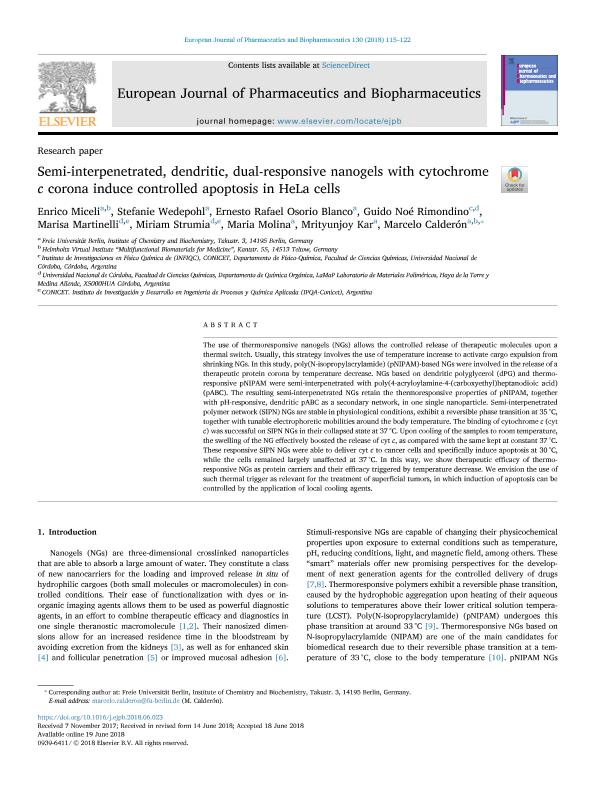Mostrar el registro sencillo del ítem
dc.contributor.author
Miceli, Enrico
dc.contributor.author
Wedepohl, Stefanie
dc.contributor.author
Osorio Blanco, Ernesto Rafael
dc.contributor.author
Rimondino, Guido Noé

dc.contributor.author
Martinelli, Marisa

dc.contributor.author
Strumia, Miriam Cristina

dc.contributor.author
Molina, Maria
dc.contributor.author
Kar, Mrityunjoy
dc.contributor.author
Calderon, Marcelo

dc.date.available
2019-10-10T13:19:40Z
dc.date.issued
2018-09
dc.identifier.citation
Miceli, Enrico; Wedepohl, Stefanie; Osorio Blanco, Ernesto Rafael; Rimondino, Guido Noé; Martinelli, Marisa; et al.; Semi-interpenetrated, dendritic, dual-responsive nanogels with cytochrome c corona induce controlled apoptosis in HeLa cells; Elsevier Science; European Journal Of Pharmaceutics And Biopharmaceutics; 130; 9-2018; 115-122
dc.identifier.issn
0939-6411
dc.identifier.uri
http://hdl.handle.net/11336/85486
dc.description.abstract
The use of thermoresponsive nanogels (NGs) allows the controlled release of therapeutic molecules upon a thermal switch. Usually, this strategy involves the use of temperature increase to activate cargo expulsion from shrinking NGs. In this study, poly(N-isopropylacrylamide) (pNIPAM)-based NGs were involved in the release of a therapeutic protein corona by temperature decrease. NGs based on dendritic polyglycerol (dPG) and thermoresponsive pNIPAM were semi-interpenetrated with poly(4-acryloylamine-4-(carboxyethyl)heptanodioic acid) (pABC). The resulting semi-interpenetrated NGs retain the thermoresponsive properties of pNIPAM, together with pH-responsive, dendritic pABC as a secondary network, in one single nanoparticle. Semi-interpenetrated polymer network (SIPN) NGs are stable in physiological conditions, exhibit a reversible phase transition at 35 °C, together with tunable electrophoretic mobilities around the body temperature. The binding of cytochrome c (cyt c) was successful on SIPN NGs in their collapsed state at 37 °C. Upon cooling of the samples to room temperature, the swelling of the NG effectively boosted the release of cyt c, as compared with the same kept at constant 37 °C. These responsive SIPN NGs were able to deliver cyt c to cancer cells and specifically induce apoptosis at 30 °C, while the cells remained largely unaffected at 37 °C. In this way, we show therapeutic efficacy of thermoresponsive NGs as protein carriers and their efficacy triggered by temperature decrease. We envision the use of such thermal trigger as relevant for the treatment of superficial tumors, in which induction of apoptosis can be controlled by the application of local cooling agents.
dc.format
application/pdf
dc.language.iso
eng
dc.publisher
Elsevier Science

dc.rights
info:eu-repo/semantics/openAccess
dc.rights.uri
https://creativecommons.org/licenses/by-nc-sa/2.5/ar/
dc.subject
Semi-interpenetrated networks
dc.subject
Dendritic monomers
dc.subject
Dual-responsive nanogels
dc.subject
Semi-interpenetrated networks
dc.subject.classification
Físico-Química, Ciencia de los Polímeros, Electroquímica

dc.subject.classification
Ciencias Químicas

dc.subject.classification
CIENCIAS NATURALES Y EXACTAS

dc.title
Semi-interpenetrated, dendritic, dual-responsive nanogels with cytochrome c corona induce controlled apoptosis in HeLa cells
dc.type
info:eu-repo/semantics/article
dc.type
info:ar-repo/semantics/artículo
dc.type
info:eu-repo/semantics/publishedVersion
dc.date.updated
2019-09-30T18:28:03Z
dc.journal.volume
130
dc.journal.pagination
115-122
dc.journal.pais
Países Bajos

dc.journal.ciudad
Amsterdam
dc.description.fil
Fil: Miceli, Enrico. Freie Universität Berlin. Institute of Chemistry and Biochemistry; Alemania
dc.description.fil
Fil: Wedepohl, Stefanie. Freie Universität Berlin. Institute of Chemistry and Biochemistry; Alemania
dc.description.fil
Fil: Osorio Blanco, Ernesto Rafael. Freie Universität Berlin. Institute of Chemistry and Biochemistry; Alemania
dc.description.fil
Fil: Rimondino, Guido Noé. Consejo Nacional de Investigaciones Científicas y Técnicas. Centro Científico Tecnológico Conicet - Córdoba. Instituto de Investigaciones en Físico-química de Córdoba. Universidad Nacional de Córdoba. Facultad de Ciencias Químicas. Instituto de Investigaciones en Físico-química de Córdoba; Argentina
dc.description.fil
Fil: Martinelli, Marisa. Consejo Nacional de Investigaciones Científicas y Técnicas. Centro Científico Tecnológico Conicet - Córdoba. Instituto de Investigaciones en Físico-química de Córdoba. Universidad Nacional de Córdoba. Facultad de Ciencias Químicas. Instituto de Investigaciones en Físico-química de Córdoba; Argentina. Freie Universität Berlin. Institute of Chemistry and Biochemistry; Alemania
dc.description.fil
Fil: Strumia, Miriam Cristina. Universidad Nacional de Córdoba. Instituto de Investigación y Desarrollo en Ingeniería de Procesos y Química Aplicada. Consejo Nacional de Investigaciones Científicas y Técnicas. Centro Científico Tecnológico Conicet - Córdoba. Instituto de Investigación y Desarrollo en Ingeniería de Procesos y Química Aplicada; Argentina
dc.description.fil
Fil: Molina, Maria. Freie Universität Berlin. Institute of Chemistry and Biochemistry; Alemania
dc.description.fil
Fil: Kar, Mrityunjoy. Freie Universität Berlin. Institute of Chemistry and Biochemistry; Alemania
dc.description.fil
Fil: Calderon, Marcelo. Universidad Nacional de Córdoba. Facultad de Ciencias Químicas. Departamento de Química Orgánica; Argentina
dc.journal.title
European Journal Of Pharmaceutics And Biopharmaceutics

dc.relation.alternativeid
info:eu-repo/semantics/altIdentifier/url/https://www.sciencedirect.com/science/article/pii/S0939641117312808?via%3Dihub
dc.relation.alternativeid
info:eu-repo/semantics/altIdentifier/doi/https://doi.org/10.1016/j.ejpb.2018.06.023
Archivos asociados
